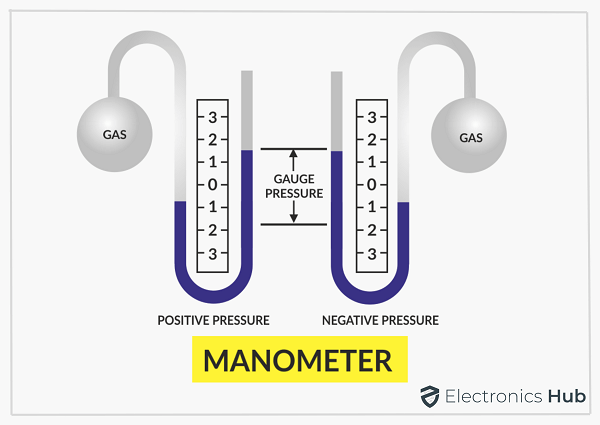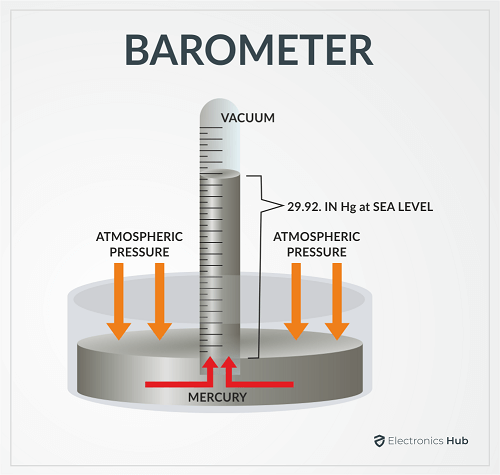You may find a barometer and a manometer in many homes, especially the old ones and the cottages or hotels beside the seashore or a beach area.
Traditionally, these two instruments keep track of the atmospheric pressure and the gas or liquid pressure in areas with unsettling weather.
But are these two the same? Well, they are not. While these two measure pressure, each one measures different types of pressure. Here is detailed information on the difference between Barometer and Manometer and why you need to use them.
Outline
ToggleAbout Barometers
Barometers measure the air pressure or atmospheric pressure to offer any possible forecast about the weather. The barometer is kept at a fixed level, and it measures the subtle changes in the atmospheric pressure caused by weather elements like storms, cyclones, etc. Besides that, a barometer can also help determine the area’s altitude. Evangelista Torricelli is the inventor of the modern mercury barometer. He invented this simple yet effective tool in 1643.
Click Here To know Manometer Vs Pressure Gauge
Different Types of Barometers
Barometers can be either made with water or mercury. Here are the common types of barometers that are used today-
-
Water Barometer
Lucien Vidi popularized the water barometer. On the other hand, Johann Wolfgang Von Goethe designed a water ball barometer by following Torricelli’s principle. This tool is known as “weather glass” or “Goethe Barometer”.
A water barometer is a sealed glass enclosure that is half-filled with water. The tool also has a narrow spout that connects to the main body. This narrow sprout-like structure has an open face, and the water in this section can interact with the atmosphere. The change in the water level of the main body and the sprout body offers a clear forecast.
-
Mercury Barometer
These types of barometers are most commonly used to measure atmospheric pressure. The structure of this barometer is pretty simple. It is made of a vertical glass tube fixed in an upside-down motion so that the open face lies within a glass bowl. Both the bowl and the tube are filled with mercury. The change in mercury level inside the tube is used to determine atmospheric pressure.
The mercury barometer comes in two variants-
- Fitzroy barometer– It is made by combining a mercury barometer with a thermometer to check out how temperature change affects atmospheric pressure.
- Fortin barometer– It looks like the regular barometer but comes with a leather valve that works as a pointer and increases the barometer’s accuracy
-
Sympiesometer
The Sympiesometer is a special barometer that is lighter in weight and compact in size. It has one mercury thermometer and a barometer combined. This tool is mainly used to measure altitude.
-
Aneroid Barometer
The aneroid barometer is a modern instrument used to measure air pressure. Lucien Vidi invented it in 1844. This tool does not use any liquid, instead uses a metal box of an alloy composed of Copper and Beryllium. This box expands or shrinks with the change in atmospheric pressure.
Working Principle of a Barometer
The barometer had a simple working principle. It measures the atmospheric pressure by balancing the weight of the liquid (mercury or water inside the glass tube against the ambient atmospheric pressure.
Mercury Barometer Working Principle
The mercury barometer or Torricelli barometer has a closed tube standing upside down on a bowl filled with mercury. The atmospheric pressure pushes down the mercury inside the glass tube at sea level. Hence, the mercury level inside the tube rises by 76cm. This is considered at 1 atm or the initial base unit.
As the attitude becomes higher, the air pressure lowers, and the mercury level inside the glass tube rises less than 76cm. This difference is used to calculate the atmospheric pressure of a certain place.
Water Barometer Working Principle
Like the Torricelli barometer, the water barometer also uses quite the same principle. But, since water is lighter in density, a larger volume of water is often required.
In the case of a water barometer or weather ball barometer, the narrow spout is open, and air pressure pushes this, and the water level inside the sprout changes as per the air pressure.
For example, if the air pressure is higher, the water level inside the spout drops compared to the bowl. On the flip side, if the water level of the sprout rises above the water level, the air pressure is lower.
- Lower air pressure often indicated clouds and rainfall. On the other hand, the weather usually remains sunny and warm with higher air pressure.
Where Are Barometers Used?
- Barometers are used in meteorology, especially in weather forecasting offices.
- The aviation sector also uses barometers to measure aircraft pressure and prepare altimeters of aircraft.
- Barometers are used to design and prepare accurate barographs
- It is also used in fluid mechanics
About Manometers

Different Types of Manometer
-
U-tube Manometer
It’s a monument made of a vertical U-tube glass column filled with a reference liquid. In general, mercury is used as a reference liquid. The faces of these columns are open, and air pressure pushes through these tubes.
One of the levels of the U -limbs is equal, and this is used to measure the atmospheric pressure.
Now, the other column is connected to the pressure vessel. This will create a difference in the liquid level in the two tubes.
-
Well Type Manometer
This type of manometer is made with a large well in one of the legs. The second leg has a tube. A small change in the tube causes a huge change in the liquid level of the well. This height difference is used to measure the pressure of a liquid.
-
Enlarged Leg Manometer
An enlarged leg manometer comes with an enlarged leg. The float is usually placed inside the engaged leg, and the two legs can be changed for different measurement spans.
-
Inclined Tube Manometer
The Inclined tube manometer has a measuring leg fixed at a ten-degree angle. This improves the instrument’s sensitivity and can measure even the smallest pressure difference accurately.
Working Principle of Manometer
The manometer uses the most liquid to measure the pressure of eternal force to determine the pressure of that particular liquid or gas.
For example, take a U-tube manometer and put liquid in the tube. If the liquid level is the same on both sides of the U-tube, the pressure is determined.
Here is the formula, P= rgh
Where P= Fluid pressure
r= the density of the fluid
g= acceleration due to gravity
h= depth
Where Are Manometers Used?
Manometers are used to measure the pressure of any gaseous or liquid matter with the help of ambient pressure.
Comparison Table between Barometers and Manometers
| Parameters | Barometers | Manometers |
| Inventor | Evangelista Torricelli | Otto Von Guyericke |
| Invented on | 1643 | 1661 |
| Variations | ● Water barometers,
● Mercury barometers ● Fitzroy barometers ● Sympiesometers ● Aneroid barometers |
● U-tube manometers’
● Large well manometers ● Micro manometers’ Extended leg manometers |
| Uses | ● Mainly used to measure atmospheric pressure
● Used for weather forecast ● Scuba divers use it to monitor their air tank ● Some smart fitness gadgets have inbuilt barometers ● Modern and digitized barometers used for GPS tracking ● Used in the aviation sector to maintain air pressure inside the airplanes |
● Measuring the pressure of air or gaseous matters
● Monitoring gas pressure in water pipelines ● Used in power plants and research laboratories |
| Advantages | ● Opaque surface for better viewing
● Non-sticky liquid gives better results ● Less chance of evaporation ● Better accuracy |
● Maintenance-friendly
● Reasonable cost of producing the instruments ● Feasible manufacturing procedure ● Good accuracy level |
| Disadvantages | ● Mercury barometers are not ideal for transportation and are not portable
● Mercury is not good for health, and if not used properly, the barometer may lead to contamination among the users. |
● Require regular leveling to get proper results
● Liquid or gas condensation can lead to errors ● Dynamic performance is not good enough |
Differences between Barometers and Manometers
Shape and Design
- Manometers- The manometers come with a U Shaped or L-shaped half-filled tube. The level change on both sides of the tube is used to calculate the liquid
Some manometers also come with pre-filled high-pressure gas. This gas puts pressure on one side, while the atmospheric pressure does the same for the other tube. The difference in liquid levels on both sides is used to determine the pressure of the liquid.
- Barometers are usually made with a large bowl with an upside-down glass tube or a connected sprout. Since the two things are connected, liquid can flow from one part to another, and the change in the liquid level in the tube or sprout is used to determine the atmospheric pressure.
Close-ended barometers may be well shaped or u-shaped. As the altitude rises, the mercury inside the tube dips. On the other hand, the water level inside the sprout changes according to high or low atmospheric pressure for water barometers.
Inner Liquid
- Manometers- In general, manometers made of glass contain mercury or other heavier liquids, But open-ended manometers also use lighter and less dense liquids like water, bromides, benzenes, and even oil.
- Barometers- Barometers, especially Torricelli barometers, are made of mercury. But, ball barometers contain water. On the flip side, the aneroid barometer uses an alloy box and does not contain any liquid.
Calculating Pressure
- Manometers- The manometers come with one open end and another one attached to high-pressure has. If the open side has more liquid, the gas puts pressure on the liquid, and the level of the open side decreases or increases. The tube on the open side has inch markings to measure the decreased or increased liquid This is used to calculate the pressure of the liquid or gas.
On the other hand, if the manometer is closed on one end and attached to a high-pressure gas on the other end, the pressure of the gas is evident with the closed arm.
- Barometers- A barometer uses the rise and fall of the mercury level or the principle of balancing the mercury or water level inside the glass tube or the sprout concerning the atmospheric pressure. The rising and falling of the liquid are measured by the inch scale marked on the side of the glass tube. The sea level air pressure or atmospheric pressure for the mercury barometer is measured at 760 mm Hg, which is considered the base level.
Purpose of Barometers
The barometers are used to measure atmospheric pressure. Hence, it is traditionally used to give weather forecasts based on atmospheric pressure. It is also used in the aviation sector to maintain comfortable air pressure inside an airplane during high-altitude travel.
Purpose of Manometers
A manometer is used to measure the pressure of gas four or liquid matters.
Conclusion
While a barometer is used to give a weather forecast by measuring the atmospheric pressure, the manometer measures the pressure of a particular gaseous or liquid matter. These two machines are different, and you cannot use one in place of another.
So, it is better to use them as per their recommended usage and follow all the necessary steps to get an error-free result.
Related Posts:
- Manometer vs Pressure Gauge - What are the Key Difference?
- Car AC Pressure Chart | Low-Side & High-Side…
- Pressure Washer Nozzle Chart | Chart of Different…
- ESP32 BMP180 Sensor Tutorial | How to Interface…
- Types of Air Compressors - Everything You Need To Know
- What is Tire Pressure Monitoring System (TPMS)? How…


